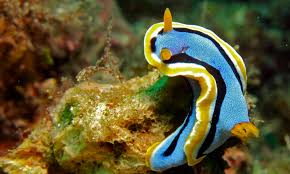Sea slugs , nudibranchs or » ocean´s butterflies» is the common name of some marine invertebrates with different levels of resemblance to terrestrial slugs, of which you´ll learn very interesting facts throughout this article.
Most of the creatures known as sea slugs are actually snails, that is, they are sea snails (marine gastropod mollusks) that apparently have lost their shells during their evolution, and they have a very small or internal shell. Let´s learn everything about them
Table Of Content
The Sea Slugs’ Main Characteristics
Nudibranchs are characterized by their bright colors, since there are no limits to the color that these creatures can have. However, a nudibranch will never see its own magnificence, since their eyes are extremely primitive and likely only detect light and dark.
Most are native to tropical waters, but 178 species inhabit in Scandinavia. They lack gills and they breathe through their skin or secondary gills (also called naked gills) located on their backs.
There is a group of sea slugs (Cladobranchia) with brightly colored organs on their back called ceratas (horns in Greek), which they use for many purposes, such as breathing and attacking or defending themselves. Sometimes the digestive system extends to these organs.
Their body is not segmented, has bilateral symmetry, an inner cavity or coelom where the organs are located, a head differentiated with sensory organs and a muscular foot in the ventral part that serves as means of locomotion.
Some species have a transparent body and the ability to emit light. Regarding their size, we can mention that they can reach up to 40 cm in length.
Sea slugs have two very colored horn-like sensory organs , located on the head called rhinophores. The lack of shell increases their exposure to predators, but through many years of evolution have developed defense mechanisms based on toxicity (acid secretion) that can be self-produced or acquired by ingesting something that contains toxins.
Sea slugs also employ camouflage to evade their predators like the sea spider just to mention one of them. Some cnidarians have nematocysts (toxin-producing cells) and since the nudibranchs usually feed on them them, they can extract the nematocysts and use them as a defensive mechanism. (We invite you to read our article jellyfish, to learn about thse cnidarians).
Here they are
Habitats and Distribution
Sea slugs are found mostly in shallow water reefs more than a kilometer deep, and often thrive in any type of water, whether cold or warm. It is important to mention that sea slugs seldomly live more than a year, which means that their life is usually very short, and the most intriguing thing is that they usually disappear without leaving any trace, it is something that many people really do not explain.
In terms of food they mostly eat seaweed, or larger species. known as sea lettuces, even fish, seahorse, starfish, crabs and sometimes they can become cannibals and eat their own species, but it doesn´t happen very often.
Striking coral reefs
Reproduction:
Nudibranchs are a hermaphrodite, which means they have both male and female reproductive organs. During reproduction, both partners exchange sperm and store it until the eggs are ready to be fertilized. The eggs are usually placed in spiral formations and offer a beautiful visual effect.
Communication:
Like many other animals, they communicate through chemical signals. During their larval stage they float in the water and don´t metamorphose until they receive the signal of a specific hormone, which acts as an indicator, for example, that there is food in the area. They can feel these chemical stimuli with the help of their rhinophores.
Main Types of Sea Slugs
Chromodoris Annae
Although they are of a really small size Chromodoris Annaeare very striking due to their great variety of colors.
Dendronotus Frondosus
These slugs grow to 100 mm and are found in southern Sweden (Baltic Sea).
Acanthodoris Pilosa
It usually reaches 40mm in length and is located on the Southern Coast of Sweden.
As it has been seen throughout this article, sea slugs are really small animals but it’s important to know them well, because although they seem inoffensive most are usually poisonous and worst of all toxic at the time of eating them.
That’s the reason why it’s always necessary to know all the species of marine animals, since many people believe that because they are in the sea there are no problems when eating it, but how you could appreciate it throughout the article, they can be beautiful only in sight, it is good to learn a little more about the sea´s wonders.
Dont´say good bye without meeting the Acanthodoris Pilosa




